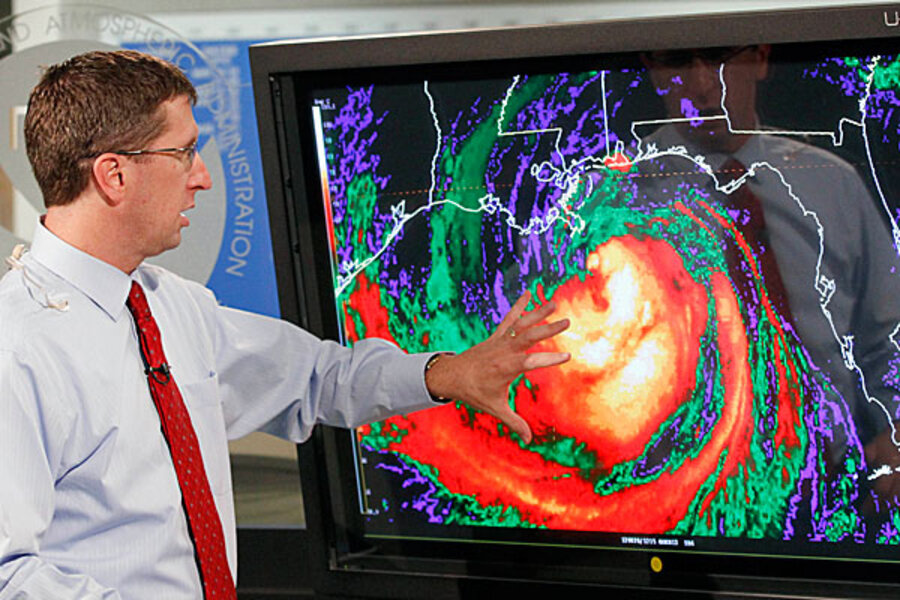Hurricane Isaac slows, sucking up energy over the Gulf
Loading...
| New Orleans
Now it's Hurricane Isaac. The storm turned into a full-blown Category 1 hurricane Tuesday as it rolled over the Gulf of Mexico toward Louisiana, where residents in four states left boarded-up homes and New Orleans waited behind flood-defense levees strengthened after the devastating Katrina struck exactly seven years ago.
The U.S. National Hurricane Center said the storm, with 75 mph (120 kph) winds, had gained strength as it moved over the warm, open waters of the gulf. It was expected to reach the swampy coast of southeast Louisiana by early Wednesday.
The focus has been on New Orleans as the massive, slow-moving storm takes aim at the city, but the impact will be felt well beyond the city limits, especially in expected storm surges of up to 12 feet (3.6 meters) in Louisiana, Mississippi, Alabama and Florida. The storm's winds could be felt more than 200 miles (320 kilometers) from the storm's center.
RECOMMENDED: 5 ways you can prepare for a hurricane
The hurricane has churned into the middle of the tight U.S. presidential election, with Republicans this week meeting nearby in Florida to nominate Mitt Romney to challenge President Barack Obama.
Obama, mindful of how his administration's response to the storm could be judged, spoke on Isaac from the White House on Tuesday morning before departing on a three-state campaign trip. The storm already had delayed the planned Monday start of the Republican National Convention.
"Now is not the time to tempt fate," Obama said. "You need to take this seriously."
The storm system was centered about 80 miles (128 kilometers) south-southeast of the mouth of the Mississippi River at 11 a.m. EDT (1500 GMT) and was moving northwest at 10 mph (16 kph), according to the National Hurricane Center in Miami. It was 165 miles (265 kilometers) southeast of New Orleans. Yesterday, Isaac was moving at 14 m.p.h.
Although Isaac's approach on the eve of the Katrina anniversary invited obvious comparisons, the storm is nowhere near as powerful as Katrina was when it struck on Aug. 29, 2005. Katrina at one point reached Category 5 status, with winds of more than 157 mph (252 kph), and made landfall as a Category 3 storm.
Mayor Mitch Landrieu did not activate a mandatory evacuation for Isaac. Instead, officials urged residents to hunker down and make do with the supplies they had.
Federal officials said the updated levees around New Orleans are equipped to handle storms stronger than Isaac. The Army Corps of Engineers was given about $14 billion to improve flood defenses, and most of the work has been completed. The levees are designed to withstand storm surges as high as 26 feet (7.9 meters) in some places.
But anxiety was high, especially in the city's Lower 9th Ward, wiped out by Katrina after floodwalls burst and let the waters rush in.
"I don't really trust the levees," said Robert Washington, who planned to evacuate along with his wife and five children. "I don't want to take that chance. I saw how it looked after Katrina back here."
His neighborhood, just a few blocks from where the floodwall protecting the Lower 9th Ward broke open, remains largely empty.
Forecasters at the National Hurricane Center warned that Isaac, especially if it strikes at high tide, could cause storm surges of up to 12 feet (3.6 meters) along the coasts of southeast Louisiana and Mississippi and up to 6 feet (1.8 meters) as far away as the Florida Panhandle.
States of emergency were in effect in Louisiana, Mississippi, Alabama and Florida. No flights were scheduled Tuesday, the Louis Armstrong New Orleans International Airport said.
The Coast Guard was searching the Gulf of Mexico near the Florida-Alabama state line Tuesday for a man who failed to return home Monday from a water-scooter trip as Isaac was approaching the coast.
The U.S. government said 78 percent of the oil production in the Gulf of Mexico has been halted in preparation for the storm as companies have evacuated 346 offshore oil and gas production platforms. That's 17 percent of daily U.S. oil production.
One question haunting locals was how much oil left over from the massive Gulf oil spill in 2010 might wind up on the beaches because of the storm. Experts believe large tar mats lie submerged just off the coast, but no one knows where they are or how many there might be.
Isaac left 24 dead in Haiti and the Dominican Republic but left little damage in the Florida Keys as it blew past.
The new hurricane was already deeply woven into political concerns beyond the Republican convention. The slow response to Katrina, which killed 1,800 and left New Orleans in chaos, led to severe criticism of then-President George W. Bush's Republican administration. This time, both Obama and Romney are cautious about the impressions made.
Obama on Monday asked the Federal Emergency Management Agency to coordinate disaster relief efforts with state and local officials along the Gulf Coast. But Louisiana Gov. Bobby Jindal, a Republican, shot back late Monday in a letter to the Obama administration that the declaration fell short of the help he was requesting.
The White House did not respond immediately to requests for comment on Jindal's letter.
RECOMMENDED: 5 ways you can prepare for a hurricane
___
Burdeau reported from New Orleans.
Copyright 2012 The Associated Press.







